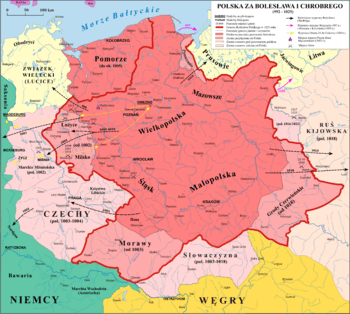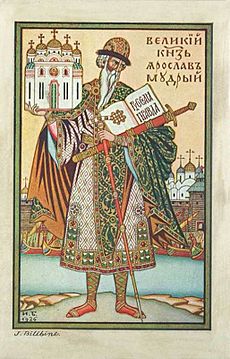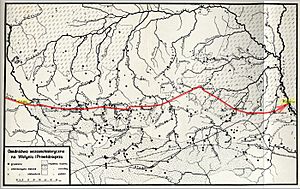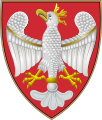Bolesław I's intervention in the Kievan succession crisis facts for kids
Quick facts for kids Bolesław I's expedition to Kiev |
|||||||
|---|---|---|---|---|---|---|---|
| Part of Kievan succession crisis, 1015–1019 | |||||||
 Kievan Rus in the 11th century, with adjoining regions |
|||||||
|
|||||||
| Belligerents | |||||||
| Kievan Rus' loyal to Sviatopolk Duchy of Poland Kingdom of Hungary |
Kievan Rus' loyal to Yaroslav the Wise | ||||||
| Commanders and leaders | |||||||
Sviatopolk I the Accursed |
Yaroslav I the Wise | ||||||
| Strength | |||||||
| uncertain: Germans (~300 knights), Hungarians (~500) and Pechenegs (~1,000 fighters), 2,000–5,000 Polish soldiers (est.) | unknown but estimated as similar to opposing size | ||||||
The expedition to Kiev by Bolesław the Brave was a big event in the fight for control of Kievan Rus' between two brothers, Sviatopolk I and Yaroslav. This happened around 1018.
Bolesław the Brave, the ruler of Poland, stepped in to help his son-in-law, Sviatopolk. At first, Bolesław's help worked. He beat Yaroslav's armies and Sviatopolk became the ruler of Kiev for a short time.
However, after Bolesław and his army left Kiev, Sviatopolk couldn't keep his power. Yaroslav defeated him the next year. Stories about this expedition mix real history with some legends.
Contents
Why Did Bolesław Go to Kiev?
Before this expedition, Bolesław I of Poland and Vladimir I, the ruler of Kiev, had fought over some lands called the Cherven Towns. Vladimir had won that fight.
Bolesław wanted to make a strong connection with Vladimir's family. He tried to marry one of Vladimir's daughters, Predslava, but Vladimir said no. Instead, Bolesław's daughter married Vladimir's son, Sviatopolk. This marriage happened between 1005 and 1013.
Family Troubles in Kiev
Vladimir had many sons, and it seems he wasn't sure who should rule after him. Both Sviatopolk and Yaroslav had problems with their father. Sviatopolk was even put in jail by Vladimir in 1013. Some people think Bolesław might have encouraged Sviatopolk to rebel.
When Vladimir died, his son Sviatopolk quickly took control of Kiev. This was because his other brothers were in different places. Yaroslav was far north, and other brothers were also away.
Sviatopolk then had three of his brothers killed. When Yaroslav heard about this, he gathered an army and marched to Kiev. Sviatopolk's rule was in danger. After a long standoff, Sviatopolk was defeated and ran away to Poland.
Bolesław, who had just made peace with the German Kingdom, decided to help his son-in-law. He agreed to send his army to Kiev.
The Journey to Kiev
Bolesław's army crossed the border into Kievan Rus' in 1018. We don't know the exact size of the armies. Some records say Bolesław had about 300 German knights, 500 Hungarian soldiers, and 1,000 Pecheneg fighters. He also had between 2,000 and 5,000 Polish warriors. Yaroslav's army was probably similar in size.
Bolesław led his troops to the Southern Bug River in July. Yaroslav's army was waiting on the other side. Bolesław took his time, letting his army rest and building makeshift bridges.
The Battle of the River Bug
The main battle happened around July 23. The Polish army attacked first. They pushed Yaroslav's soldiers away from the riverbank they were guarding. Bolesław's army quickly crossed the river.
Yaroslav's army tried to fight back but quickly fell apart. Many of Yaroslav's soldiers were killed as they ran away, but only a few of Bolesław's soldiers were lost.
There are different stories about how the battle started. One story says that Bolesław's servants, who were preparing food near the river, got annoyed by Yaroslav's archers. They crossed the river and chased the surprised enemy soldiers away. Bolesław then quickly moved his army across the river and won.
Another story says that Bolesław was angry about insults from across the river. He charged with his army, surprising Yaroslav and scattering his forces. All stories agree that Bolesław won the battle.
After the defeat, Yaroslav went north to Novgorod. He didn't go to Kiev because he probably knew he couldn't defend it. Kiev was already being attacked by Bolesław's Pecheneg allies. In Novgorod, people convinced Yaroslav not to give up and to fight back.
Kiev Falls
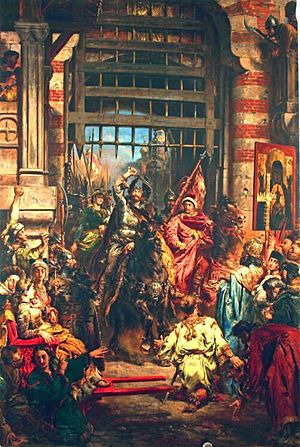
Bolesław's victory at the river opened the way to Kiev. The city was already suffering from fires caused by the Pecheneg attacks. Kiev surrendered on August 14 when Bolesław's main army arrived.
Bolesław and Sviatopolk were welcomed into the city. The local archbishop greeted them at the church of St Sophia.
A famous Polish legend says that Bolesław hit the Golden Gate of Kiev with his sword, the Szczerbiec, as he entered the city. This legend is not true. The gate was built much later, and the sword itself was made 200 years after Bolesław's time.
After Sviatopolk was back on the throne, Bolesław sent his German and Hungarian soldiers home. It's not clear how long Bolesław stayed in Kiev, but it was likely only a few months.
Some old records say that Sviatopolk ordered all Polish people in Kiev to be killed because of their plundering. This unrest supposedly forced Bolesław to leave Kiev. However, other historical accounts don't mention this. They simply say Bolesław returned to Poland after putting his brother-in-law back on the throne.
When Bolesław left Kiev, he took some of Yaroslav's family members as prisoners. This included Vladimir's widow and Yaroslav's sister, Predslava, whom Bolesław had wanted to marry earlier. He also took a lot of treasure from Kiev.
Historians believe Bolesław's main goals were to get back the Cherven Towns for Poland and to help his family member, Sviatopolk. The expedition also allowed him to get rich from Kiev's famous wealth. Bolesław made the people of Kiev support his soldiers and collected a lot of tribute, which he shared with his allies.
What Happened Next?
Sviatopolk lost the throne soon after Bolesław left and died the next year. Bolesław was busy with other conflicts in Poland, so he didn't help Sviatopolk again. Instead, he made a peace agreement with Yaroslav, who had successfully taken back the throne of Kiev.
Even though he lost control of Kiev, Bolesław managed to keep the Cherven Towns that Vladimir the Great had captured earlier. Bolesław was crowned King of Poland in 1025. Yaroslav lived longer than Bolesław and made Kievan Rus' much stronger.
Images for kids


